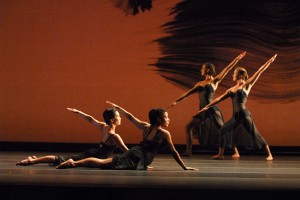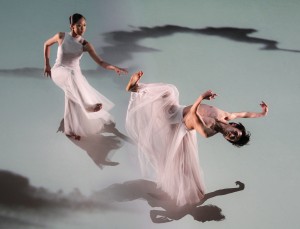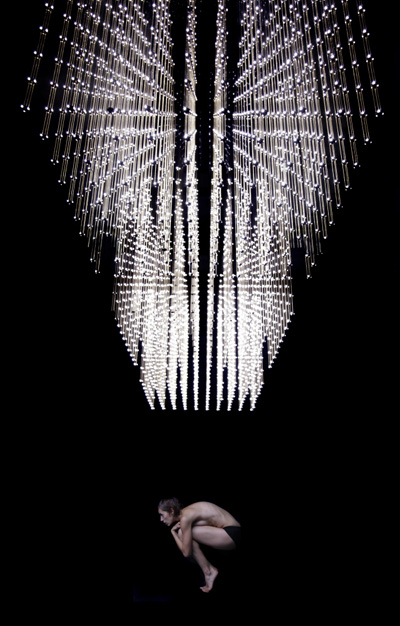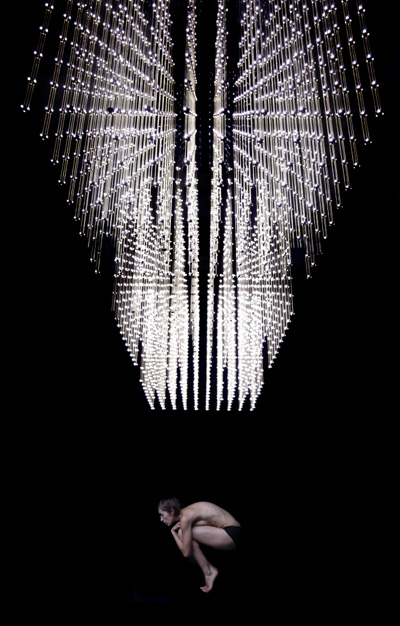Human Beauty: Wayne McGregor’s Movement Research

Photo: from AtaXia.
There is a long tradition of work fascinated by difference: last month’s Einstein on the Beach, is based on the writings of Christopher Knowles, an autistic poet, and collaborator of Robert Wilson. In AtaXia, a sci-art dance he created in 2004 by Wayne McGregor, disability and bodily difference emerge as formal movement principles, and create a new attention to different ways of being in space.
McGregor choreographed AtaXia after an eight-month research fellowship at the experimental psychology department at Cambridge. Merging scientific research and movement research, he based the dance on the disorder named by its title. McGregor, a group of neuroscientists, Sarah Seddon Jenner who has an ataxic movement disorder, and Random Dance’s troupe of well-trained, professional dancers all worked together to choreograph a dance based on a medical condition which disrupts movement, and overloads nerves.
And it is not just the bodies that play with disruption, starts, stops, overload: AtaXia’s stage has a mirroring backdrop, multiplying the movements and bodies on stage. The bodies flash in costumes shot through with fiber-optics, lighting up movements and speed. In the patterns of the dance, an arm’s arc gets arrested, thrashes, hacks at the air.
Curiosity and both scientific and artistic research shaped the creation of the piece. Jenner describes her interaction with the company:
I came back for a 135 minute question and answer session with the company, during which we covered many of the things they had learned in the research context, as well as working through some of their own observations about movement, dysfunction, and how bodies cope with impairment.
The whole piece really started to make sense to me, though, after a rehearsal I did with the company during which one of the dancers (Leila Dalio) and I worked through some choreographic exercises.
The whole company, including Wayne, was in the room, but they all appeared to be working intently on their own material. I was concentrating on lasting three hours without a) forgetting my movements; b) injuring Leila by leaning on her too much; and c) falling over. So, I didn’t realize until I saw the finished dance how carefully I’d been observed.
Some examples of ways I move that made it into the finished piece. I scoot on my backside along the floor rather than stand to move from one place to another. I touch people and things not so much to bear weight as to help orient myself relative to them. As I get tired, I lean on others for support and more often than not, I get that support.
In her discussion with me, Jenner mentions that her contact with the dancers taught her important information as she continues to adjust to living with ataxia: the information reflected back to her by the trained bodies of dancers, well-used to picking up unusual movement information and structuring it. Through these translatory processes, Jenner’s embodiment echoes back to her across the image of the dancers on stage – a new image of her own movement quality emerges for her.
Jenner shared with me her emotions about experiencing her movement mirrored back to her. Mainstream aesthetics see disability so often only as a tragedy, as something to be overcome (and this attitude is easily internalized). In this collaborative research process, her condition became the source of exciting movement patterns, of intriguing human difference.
PK: What did YOU learn about your own movement by watching the dancers in the performance? Did anything surprise you? What and why?
SSJ: There are specific gestures in AtaXia that are typical of those with neurological impairments that I despise catching myself make, and I surprised myself with how negative and judgmental I feel about them. (Specifically, jerky arm gestures and the tendency to hold the arm close to the body, fully flexed at wrist and elbow). One dancer explained that the shame and hostility I associate with those movements are learned social responses and that they are not intrinsic to the movement. It was all I could do not to snap back, “I hate them anyway.” I find that now that I’ve seen them performed, the sting has gone out of those gestures and I don’t even mind seeing them in the mirror.
Some critics call Wayne McGregor’s choreographies distant, or cool. As I give myself to his intricate spectacles, I remember the empowering effects of movement research on Jenner, and enjoy the play with the movement differences our world has to offer.
Editor’s Note: Wayne McGregor and Random Dance come to Ann Arbor to perform Far on February 19, 2012.
11/12 Dance Series
The UMS Dance Series includes four events in Ann Arbor’s Power Center. The series begins with the Mark Morris Dance group performing two nights of new repertory. Two companies make their UMS debuts: Taiwan’s Cloud Gate Dance Theatre with Water Stains on the Wall and Random Dance, a company started by Wayne McGregor, whose groundbreaking collaborations across dance, film, music, visual art, and science are evident in the company’s presentation of FAR. Finally, Ballet Preljocaj’s production of Snow White, set to music by Gustav Mahler and featuring costumes by Jean Paul Gaultier, closes the dance season.
Subscription packages go on sale to the general public on Monday, May 9, and will be available through Friday, September 17. Current subscribers will receive renewal packets in early May and may renew their series upon receipt of the packet. Tickets to individual events will go on sale to the general public on Monday, August 22 (via www.ums.org) and Wednesday, August 24 (in person and by phone). Not sure if you’re on our mailing list? Click here to update your mailing address to be sure you’ll receive a brochure.
Mark Morris Dance Group
Friday & Saturday, September 23 & 24, 8 pm
Power Center
Mark Morris has changed the way that audiences see modern dance, with unique artistry that reflects a profound and sophisticated love of music. His company of exuberant dancers lives up to its reputation of wit, grace, and a refined musicality that is further reinforced by Morris’s use of live musicians in every performance. These two performances feature new Morris repertoire.

Program
Excursions (Barber’s Excursions for Piano, Op. 20)
Festival Dance (Hummel Piano Quartet)
Socrates (Erik Satie’s Socrates for tenor and piano)
Water Stains on the Wall
Cloud Gate Dance Theatre
Lin Hwai-min, artistic director
Friday, October 21, 8pm
Saturday, October 22, 8pm
Power Center
Trained in tai chi, meditation, Chinese opera movement, modern dance, and ballet, Cloud Gate Dance Theatre performs a rich repertoire with roots in Asian myths, folklore, and aesthetics, all infused with a contemporary perspective. For this long-awaited UMS debut, Cloud Gate presents Hwai-min’s newest work, Water Stains on the Wall. “Water stains on the wall” is a popular metaphor that represents the highest state in the aesthetics of Chinese calligraphy. Hwai-min and dancers take off from this metaphor and create and abstract work of beauty and magic that stands sublimely on its own.
FAR
Random Dance
Wayne McGregor, artistic director
Friday, February 17, 8 pm
Power Center
Random Dance was founded in 1992 and became the instrument upon which Wayne McGregor evolved his drastically fast and articulate choreographic style. The company became a byword for its radical approach to new technology, incorporating animation, digital film, 3D architecture, electronic sound, and virtual dancers into the live choreography. In FAR, cutting edge design is fused with choreography made from a radical cognitive research process. FAR “talks about the Enlightenment’s fascination with the working of the mind and the dissection of the body…draw[ing] to a close with…the utmost tenderness and finality.” (The Times, London)
Snow White
Ballet Preljocaj
Angelin Preljocaj, artistic director
Thursday, April 19, 7:30 pm
Friday, April 20, 8 pm
Saturday, April 21, 8 pm
Power Center
After more than a decade since its UMS debut, Ballet Preljocaj (pronounced prezh-oh-kahzh) returns with its production of Snow White. Angelin Preljocaj has created a work for all 26 dancers of his company, setting the Grimm brothers’ version of the fairytale to the most beautiful scores of Gustav Mahler’s symphonies for this romantic contemporary ballet. With costumes designed by Jean Paul Gaultier, this production of Snow White is sure to shake up those who have grown up with only the Disney version at their disposal.
Return to the complete chronological list.
Renegade Series
Renegade
The focus on “renegades” in the 11/12 season examines thought-leaders and game-changers in the performing arts and encompasses performances that are part of the UMS International Theater Series, Choral Union Series, Divine Voices, Dance Series, and the Chamber Arts Series. Performances under this umbrella will take place in a ten-week period from January – March 2012 and include:
- Philip Glass & Robert Wilson’s Einstein on the Beach
- From the Canyons to the Stars, performed by the Hamburg State Symphony
- The Tallis Scholars, performing Tenebrae Responses by renegade Italian Renaissance composer Carlos Gesualdo
- Random Dance, a company started by Wayne McGregor , the resident choreographer at The Royal Ballet, Covent Garden, whose groundbreaking collaborations across dance, film, music, visual art, and science is evident in the company’s presentation of FAR
- Robert Lepage’s The Andersen Project, a solo performance created by this Canadian theater visionary that explores sexual identity, unfulfilled fantasies, and the thirst for recognition and fame through Hans Christian Andersen’s timeless fables
- The four concerts of the San Francisco Symphony’s American Mavericks festival. In addition to the three orchestral concerts noted in the Choral Union Series, members of the San Francisco Symphony will present a chamber music concert to close both the American Mavericks festival and the UMS focus on Renegades.
Subscription packages go on sale to the general public on Monday, May 9, and will be available through Friday, September 17. Current subscribers will receive renewal packets in early May and may renew their series upon receipt of the packet. Tickets to individual events will go on sale to the general public on Monday, August 22 (via www.ums.org) and Wednesday, August 24 (in person and by phone). Not sure if you’re on our mailing list? Click here to update your mailing address to be sure you’ll receive a brochure.
Return to the complete chronological list.






